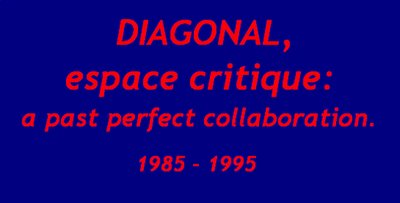

 In Britain mini-feslivals of
In Britain mini-feslivals ofInternational Performance Art
were virtually unheard of in the 1980's
and possibly the 90's.
However,
by 1984,
such alternative festivals had become
a regular feature of artistic life
in most European countries thanks,
in large part,
to the efforts of one man,
EGIDIO ALVARO.
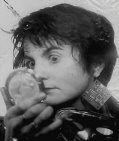
TARA BABEL
participated in several of his events
in France and Portugal.
Here,
(originally pupblished in Performance Magazine [UK], September/October 1987 - Nº49)
she reviewed INTERVENTION 3
as well as talked to its prolific and charismatic organiser...

INTERVENTION 3,
A past & past perfect review
VERRIÉRES,
the name referred to the glass skylights,
of the working studio/loft-like space
of seven French artists,
who had shared the bright spacious atelier.
The 14th district of Paris,
traditionally recognised as an artistic stronghold
for young contemporary artists,
seemed to live off the bygone days
and romantic notions
of a reputation that had kept Paris
the centre of the art world for many generations.
 The reality of the eighties had brought
The reality of the eighties had broughta keener sense of practicality
and a wider margin for experimentation.
Verrieres, as a group of artists,
were developing this potential,
collaborating with other organisers,
opening their studio doors
for well publicised exhibitions of their own work
and lending the space to more alternative ventures
such as INTERVENTION,
which was
a series of International Festivals of Performance
organised by an extraordinary Portuguese man,
Egidio Alvaro.
Alvaro was co-ordinator of Diagonale/Espace Critique,
`professor´ of the course 'Performance in Europe'
at the University of Paris (VII),
organiser of many festivals around Europe and sometimes,
further afield in North America.

He never seemed to miss whatever opportunity
to meet and search out new artists and venues,
which enabled him to create a continual chain of events
and dialogue in the area of live art.
So,
were you ever summoned by Alvaro for an intervention event
you would have been well advised to drop everything and go ...
had you wanted to witness an event injected with spontaneity,
energy and something different.
I caught the train and Dover/Calais ferry boat
for the third edition of INTERVENTION
which took place on the 5th and 6th May, 1987.
INTERVENTION 3 came about
through an exchange with Germany,
when in 1986,
Egidio took a group of Parisien artists to Cologne ...
to Moltkerei Werkstatt,
and by subsequebtly enlarging and expanding the workshop's exchange
to include twenty or so artists from France, ltaly, Portugal,
Germany and the UK ...
all of whom who had gathered at Verrieres
for those two rather compact days
financialIy assisted by OFAJ
(Office Franco-Allemand pour la Jeunesse).
The events were indeed varied including:
action painting, dance, improvised music,
multimedia performance and a specially made sound sculpture
by German artist Gunter Demnig.
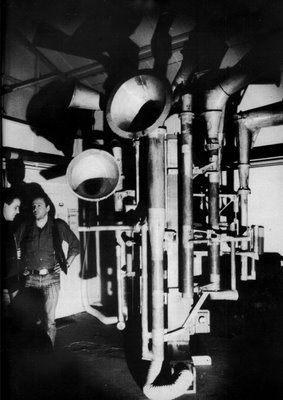
Much of the improvised dance
had been rather predictable,
suspicious in its concept and
at times
unbearably embarrassing to watch.

The dance groups in attendance were:
Multitude, (France & pictured above),
Angie Heisl, (Germany & pictured below)

and Maroussia Vossen accompanied by Jacques Bruyere,
(France & pictured below).
The latter had stirred up the most vitality:
a gymnastic dancer and a lone percussionist
whose beats assaulted the high ceilinged room with aggression and defiance,
the dancer's body competing against the drummers rhythmic virtuosity.

There had seemed to be a revival of action painting in Europe,
although I suspected it had never really been entirely out of fashion.
Painters in action sought more than the two dimensional surface of the canvas.
They had become aware that the process always supersedes the end result,
that the confrontational aspect of this process produces,
in effect,
an authentic and positive perception of a visual image.
Jacques Guého and Luc Lerouge,
two experienced painters
carry out their tasks with a passionate conviction and intent
that encompasses personal concepts, visual imagery, and immediate reaction.
Guého began from behind the audience,
lecturing the bemused onlookers in an exaggerated dramatic fashion,
wearing a straw hat and wrap around skirt.
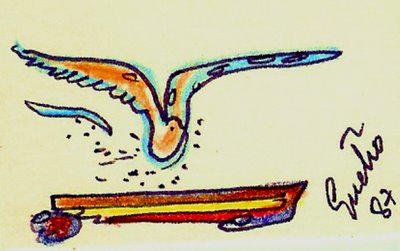
Barefoot
he approached his paper
to the accompaniment of a latin American congo drummer
whose rhythms seemed to have dictated the marks made on paper.
After about twenty minutes
Guého produced the painting:
'Liberte, Quelle Liberte!'
a kind of mythological birdlike figure suspended in flight.
Luc Lerouge attacked his surface
with paintbrushes attached to long sticks like spears,
he leaped about and acted instinctively,
taking perhaps a few seconds to decide the next colour.
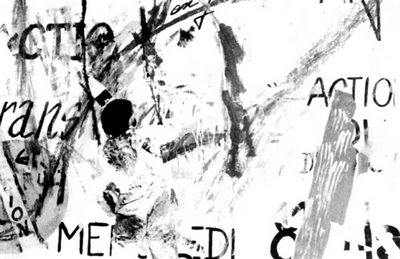
The audience had responded enthusiastically,
and sometimes even heartily applauded
if they agreed with a certain colour.
Toward the end
two people beside me had started to giggle uncontrollably
as Lerouge ekked out the finishing contours in black paint.
There
I became even more aware of a different attitude
to live art in Continental Europe than in Britain.
The Continental European seemed less restricted and reserved in their reactions.
The Portuguese contingency,
had always been present at an Alvaro festival
and on this occasion consisted of Antonio Olaio and Icaro.
Olaio rated highly as a painter in Portugal
and his live work had always seemed to add
a kind of whacky humour to any event.
He has an amazing voice which he used for his sung piece:
The Cross-eyed Reporter.
His lyrics amounted to surreal poetry:
juxtaposed phrases and played on puns.
Olaio sang and danced using instant props:
telephones, plastic bin liners, cut up card
and a translation in French written on a long roll of paper.
He was extremely funny.
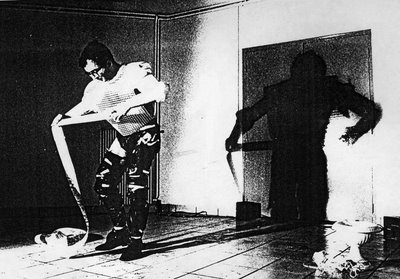
Upstairs,
the wonderful Icaro created a night time spectacle.
Under a strobe the artist ran around,
sometimes pressing envelopes into peoples hands,
or working with objects on the floor,
culminating in a shower of glitter
which looked beautiful in the efect of the flickerig light.
The ambiguity of his actions under the strobe,
had worked like a short and sweet dream.
Elizabeth Morcellet
had leant toward a more theatrical approach to performance.
She had and still works extensively (since 1978)
in Europe and at that time
lived between Paris and Nice.

Her work of the period
was mainly derived from 'memory',
(in that memory always traverses a present time)
and then,
took the form of short vignettes of romantic encounters,
ambiguous relationships
and the projection of her own sexuality.
Her series of the time were works that became
a kind of scenario.
She picked out a man to work with her 'en directe'.
In the scenario,
she desired of him certain things:
fighting, waiting, crying, laughing, leaving ...
basically the stereotyped behaviours of a relationship.
Face slapping and kissing were very real in her work.
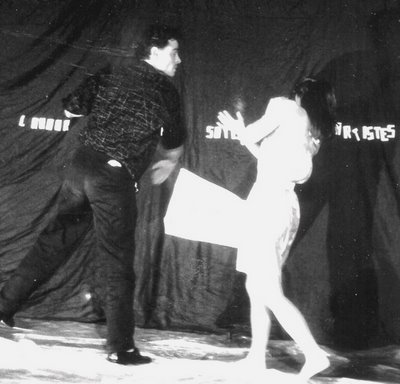
The live action
was the first experience of these things for the characters,
and therefore was real,
an experience of life for her.
She expressed her femininity
as the male character became her object of desire.
She was at once humiliated,
loved, abused and admired,
not only by the man but by the audience as well,
who assumed a voyeuristic position.
I was convinced and moved by her actions.
Another favourite of the solo women performers
was Catherine Meziat.
Her performance:
'How to Believe What You See',
used delicate illuminations,
strips of light projected as slides.
She moved dreamlike as the light passed through her body,
moving toward and away from the source of light.
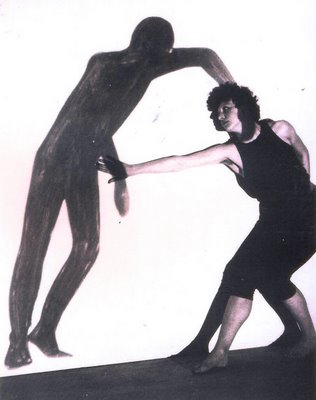 With the applied pressure of a foot,
With the applied pressure of a foot,she burst numerous little bags of water on sand,
which hinted of the sea.
In the smokey, boozy atmosphere,
her action was like a breath of fresh air.
In contrast,
the raucous Marie Kawazu directed and manipulated her audience, gathering 'volunteers'
and putting coolie hats on them in a bizarre parody of the orient.
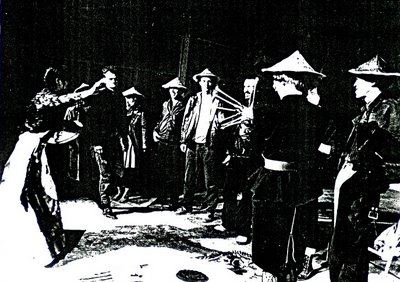
As a personality she is extrovert and energetic
but in a performance she becomes dynamite,
bright garments and colourful props enhance the organised chaos.
Her work is carried by her forceful nature
and incredible voice with a confidence
which had often lacked in live performers of the day.
The duo Schmiz & Drux
from Cologne
had devised a piece:
Pour une Frau et un mann.
They had been working together since 1983
and their themes were based on day to day existence,
their situation as man/woman,
as artists, and the artists products.
In the event catalog they had stated
that their performance functions on three levels:
1) Language ie text compositions,
2) Visuals ie room installation,
3) Dramaturgy ie theatre-like actions.
A major component they had used was plastic
(floor covering and plastic figures).
Their life size sculpture Schmiz & Drux,
a representation of themselves,
came to life through their creators' actions.
 They worked up and down the space,
They worked up and down the space,the seated plastic couple were at one end,
slide projector at the other
as they realised ten acts 'for the "bourgchoix" internationaux',
translating their script from German into French,
they moved together in sync,
perfectly composed,
leaping over the plastic figures
to finally exchange places with them
in what was a a well rehearsed,
witty and harmonious performance.
The construction of Plastic figures,
the interest in theatre,
the search for a direct and concrete form of expression,
a continuous awareness of the body
and usage of artistic language
were all characteristic in the art-performance of Schmiz & Drux.
Finally of interest was R. U. Sevol, a Neoist,
(of an international conspiracy founded in Montréal, around 1979).
From what I was able to gather,
Neoism used a collective code of language and gestures or 'activations'
carried out by Neoists the world over.
At the time, Sevol was using his catchword 'anti-neosim'
which described the element of black humour present
in his activation of Neoist themes.
The Neoist Activation at INTERVENTION 3,
was yet another version of 'Ism History' during which
Sevol washed rags inscribed with the various 'isms' of art history ie: expressionism, rayonism, minimalism, opism etc,
and hanged them on washing lines to dry out.

He had previously used plates for the 'isms'
and the theme was repetitive.
At the time,
Sevol was also working on his first non-neoist performance
(not activation) titled:
Lune de Fiel,
a pun on the French term for honeymoon, (lune de miel)
loosely translated as bilemoon.
I have a feeling it will be a strong work.

What the greatest thing about Alvaro's festivals was,
was that firstly
he layed down a challenge to artists in many ways
and he opened doors for a wider communication
between people as people
and people as artists.
I thought he was essentially a very important figure in Live Art in Europe
yet he himself,
had always kept a low profile.
During INTERVENTION 3, in '87,
I put some questions to him
so as to discover more about his motivations,
projects of the period and raison d'etre:

Tara Babel:
How long have you been involved with
experimental/performance work?
Egidio Alvaro:
Since 1974.
In Porto, Portugal,
I organized an international festival
that brought together 13 artists.
Each had a week to show an exhibition
or do an installation
and they could intervene with performances.
Each week there was one or more open discussions
between artists and the public.
This took place just before the Portuguese revolution,
attendance was high and so was the interest.
That festival was a real turning point for young Portuguese artists.
It gave them their first opportunity
to talk and live with quite important international artists.
I had invited Miller and Cameron from England
and Robin Klassnick of Living Spaces.
It was at that point in time
that international exchanges were born in Portugal
which,
each time afterwards,
brought together sixty or more artists from many countries.
Later
I created Alternativa,
International Festival of Living Art.
TB:
Does your association with live art
relate to any part of your background or experiences?
EA:
My interest in living art came after deep reflection
on the actual role played by the art critic
in contemporary society and also
from my previous involvement in 16mm film,
literature, cultural activities within the community
and also my interest in African rituals.
I realized that the critic's role
as chronicler
or as mouthpiece of such and such fashion
didn't suit me.
At that time,
I was far more aligned with a Dada
or even Futurist spirit
rather than a desire for any sort of career as socio-critic.
Later,
my sentiments were reinforced
thanks to acquaintances I had among artists
and organizers of Happenings,
Fluxus and Body Art.
In any case,
I was always independant,
inflexible under pressures of the market
or in accepting institutional compromises.
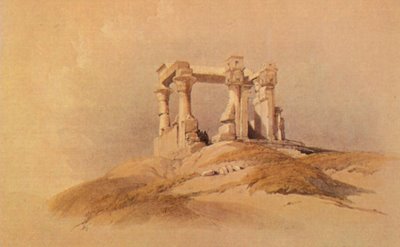
TB:
There don't seem to be many people around
that are as (unselfishly)
supportive and enthusiastic about promoting
and presenting performance work
in a wide variety of different venues,
as you are.
Have you got an ulterior motive?
EA:
Of course!
Step by step...
the more I organized festivals,
the more I became aware of the undermining radical change
in socio-cultural modes that they entailed
and of the importance of such alternative manifestations
in the future of contemporary art
because I have always felt art to be a product of civilization.
The institutional system of the time was evolving, more and more,
toward an essentially market oriented concept.
It was that which motivated me in keeping alive and operational
the spark of methods capable of taking in hand,
even with little funding,
the necessary mutation of art.
On the other hand,
the heated contact with artists
whose creativity struck me as being strong and revelatory,
facing up to problems running through contemporary creativity,
the desire to go as far as is possible
in the sense of
provoking and conducting a veritable current of innovation in art history,
the fascination that this adventure and the difficulties it exerts upon me ...
all of these
have given me sufficient motives to continue.
TB:
Apart from running Diagonale,
do you have an obligation to the 'art world'?
EA:
I've founded two reviews,
art reviews;
first Artes Plasticas in 75,
in which I'd made known many young artists and critics
and then after, in '85,
Interface.
Interface was to take a preponderant role
in the field of new artistic forms and medias
(performance, video, visual poetry, installation,
mail art, xerography and the most recent contemporary music)
and also in the listing of international events that were most significant.
I also write many texts for artists
whose work interests me and I try to project something other than the conventional image of the art critic,
one that is non conformist in the field.

TB:
Do you yourself make art?
EA:
In so far as
I see a festival as a living entity,
a separate sort of creation in itself as a whole
with all its particular roles ... I do make art.
I therefore work with a difficult medium to grasp and understand
on every level ...
for example, a city:
(with all its social strata, political/cultural nooks 'and crannies,
its own interests, hatreds and incomprehensions)
and a living pigment,
the artists themselves who participate in the festivals
and whose motivations and work I know
and whom I integrate into the weaving of an evolving action
that often finishes at its climax
and which can also leave behind cultural time bombs
that could eventually change the evolutionary course
of the micro societies where I present such work.
Less directly, though, I also do mail art.
The way I conceive it
is very personal,
a sort of enquiry into the questions that occupy me:
the role of artist and art,
creation and perception.
TB:
How do you see performance in relation to a gallery situation?
EA:
It will always be bad for a gallery to take on the context of performance,
there is nothing or almost nothing to gain.
Performance requires a lot of investment and energy.
Very often, traces of a performance are left on floors and walls
that can't be removed.
The galleries today that are interested in performance
put it on mostly as a form of mundane publicity which is irrelevant.

TB:
BriefIy,
what do you talk about at your lectures at Universite de París VIII?
EA:
At l'Universite de París VII,
I screen videos and project slides
of work by European artists in performance
and try to analyse their specific field of performance.
My lectures are structured by country and,
therefore, I point out the cultural identity,
roots and the mark made in areas of experience in daily life
by each artist.
Also, their parallels and differences.
TB:
Do you think that conditions for a working artist should be easy or difficult?
EA:
That depends on the artist.
However,
I think that each artist should be able to use the mínimum at hand
that is indispensable and necessary for their work/creation.
Today's art is not only the activity of certain isolated individuals,
it is a powerful machine of evolution and change
and the kind of art being done
is decided each day in the arena of metropolitan centres.
The artist's freeplay should be let loose.
Most often, sadly enough,
institutions act as the breaking system of this motor,
occulting barriers
or as voids of silence
rather than in their primary role
which should be that of catalysts supporting creative research.
TB:
Would you agree that
the work of contemporary women performance artists
seems to be more predominant than that of their male counterparts?
EA:
That varíes from one country to another.
In Latin countries the number of men in performance is greater.
In Northern Europe,
the number of women that invest themselves
in this creative domain is more significant.
It seems to me that a direct relation exists,
rather than a subtle one,
between this situation and the cultural role played by women
in each society and culture.
In so far as the quality of the work itself is concerned,
I think that women are more percussive,
more direct and closer to suffering.
They sum up very quickly, and "re-see" reality
with an amazing emotional power.
As for men,
the "thought process" is frequently conceptual,
rather more detached and abstract.
Yet,
of course,
this is but my impression of the two
that does not take particular cases into account.

TB:
Whose work do you most admire at present?
EA:
Each,
for particular reasons,
that I've tried to outline better in my texts
but
any list would take into account those I've seen
and name those I've read about
and also
artists whose work strikes me as being singularly powerful:
Miguel Yeco, Elisabete Mileu and Antonio Olaio, from Portugal;
Jordi Cerda, from Spain;
Roberto Barbanti, from Italy;
Orlan, Plassun Harel, Catherine Meziat, from France;
Marie Kawazu, Mineo Ayamaguch, from Japan but living in Europe;
Claude Paul Gauthier, Claude Lamarche, Nathalie Derome, from Québec;
Jorge Pell, from Argentina;
Kees Mol, Lydia Schouten and Marcelle van Bemmel from Holland;
Ria Pacquee, from Belgium;
Natascha Fiala, Susanne Kirst, Stephen Reusse, from Germany;
Miller and Cameron, Rose English from Britain;
Allana O'Kelly, Nigel Rolfe, from Ireland,
and a good many others but my list is too long.
TB:
A lot of British artists
are quite unaware of what is happening around Continental Europe,
is this the situation vice versa,
or do you think it may be a fault with the British side?
EA:
The situation is comparable on both sides of the channel
and is aggravated when Québec, Latin America and,
well,
when most Latin countries in general are mentioned.
It's because of,
in many cases,
the weight of institutions that don't fund,
independent festivals that don't subsidise young artists
(particularly those in performance judged too scandalous).
Institutions filter information.
They silence or gag that which is alive,
untameable and racy.
Also,
the artists themselves aren't sufficiently organised
(and never will be)
to take charge of the whole operational and promotional vistas.
It's in exactly that capacity
that critics like myself could play a decisive role.

TB:
Sometimes in the UK,
as has happened here,
performances have been censored (by the authorities)
before public presentation,
how would you deal with that?
EA:
Personally,
I've always put on the restricted.
If I feel an event should have a place in a programme,
I'll do everything possible to ensure that it be done.
I then as sume all consequences,
it has already happened a few times.
In any case,
if we believe ourselves to be in the right,
censorship should not stop us.
If we accept brutal censorship,
we place ourselves in a position
that is very close to accepting censorship's most insidious form;
autocensorship.
That kind which is associated with the real of museum,
gallery,
media and art review blacklisting.
If we have to cross that desert,
we shall cross that desert.

TB: What have you planned for the future?
EA:
I'm in the midst
of activating the extraordinary Alternative European Circuit,
organising festivals here and there
and will do practically anything possible
to participate in those organised by others.
At the same time
I'll organise a big intercontinental festival
for European artists to go to Québec and New York
and that artists from both places should come to París.
Later,
and it's already on the board,
I'm thinking of Africa and Japan.
In the meantime
I'm always co-ordinating a festivals in Porto, Portugal:
international festivals of performance and video.
Then, here in París,
international festivals of music, dance and performance.
Travel,
confrontation,
dialogue,
direct experience of life now, for the future of art in general
and toward a stronger reason
for the coming of age of ephemeral performance.
(This interview was recorded in French and translated by R. U. Sevol)

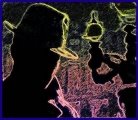

0 Comments:
Post a Comment
<< Home